Is airbrushing indoors safe? Do you want to airbrush miniatures, but don’t have a window for ventilation? Airbrushing is a great way to paint miniatures. There are a lot of techniques with an airbrush that can speed up your model painting, as well as create some really cool special effects. But, if you don’t have an outside window and the proper ventilation (not something most people will usually contemplate or even think about), you can still airbrush indoors.
In this article, I share with you how I airbrush inside my hobby room without windows for ventilation. Read on below to see 5 tips for how to safely use your airbrush indoors to paint miniatures and models.
Why Airbrush Indoors With No Window?
If you cannot airbrush outdoors, there are some reasons you might not want to:
When light levels decrease in winter, e.g., cloud cover, less sunlight, it becomes much harder to see the colors on your palette or model. This makes it more difficult to see what you are doing. Another obvious reason you may want to step inside to airbrush is the reliance on good weather. High humidity or extremes in cold or heat, rain or snow will make airbrushing inconvenient or outright impossible.
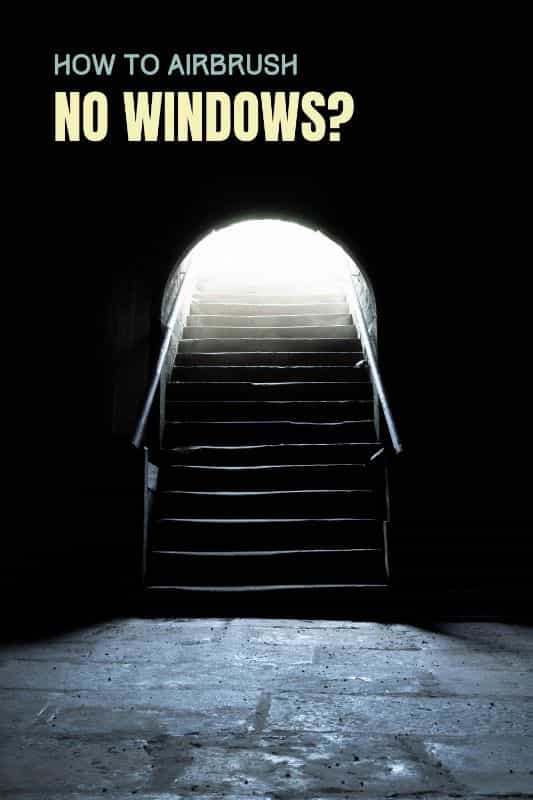
The ability to airbrush indoors solves all these problems with airbrushing miniatures outside. Inside you’ll find comfort, good lighting and even the liberty of those late-night painting sessions. Sure, you may want an additional hobby lamp or extra lighting but there are plenty of options for us.
For most miniature painters, airbrushing is not their only painting approach but when hobby time is limited, an airbrush can make some projects move so much faster. And, so there’s always a reason to optimize for convenience and safety!
Is Airbrushing Indoors Safe for Painting Miniatures and Models?
Yes, in general, I think airbrushing acrylic model paints indoors is safe with the proper conditions. I’m not an expert on the toxicity of paints (there aren’t many experts in this area); but I think that as long as you have proper ventilation or a good air filtration system, you should be safe when airbrushing non-toxic hobby paints.
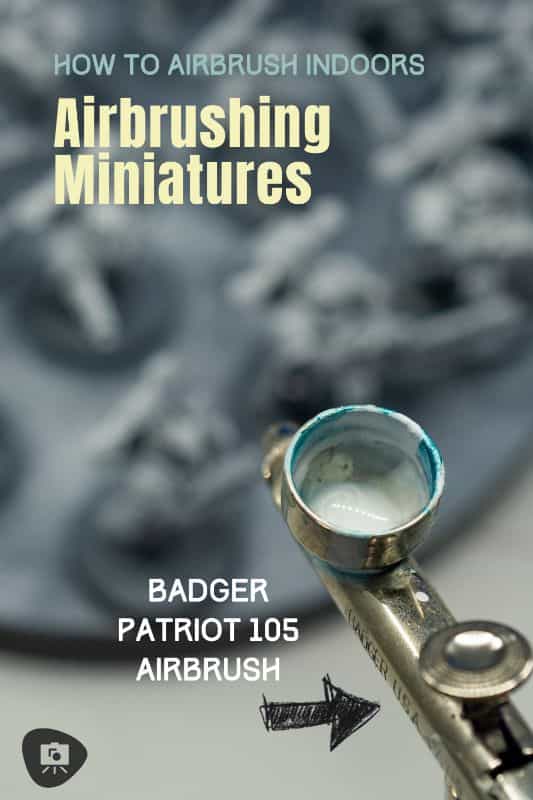
At the minimum, I would always recommend wearing a dust mask when airbrushing indoors, to avoid breathing in any paint overspray from your airbrush. A paint booth may be necessary if you use harsh solvent based paint, such as enamel paints, which release paint fumes when aerosolized. Over spray from an air brush or rattle cans will require you to contain the fine particles.
Indeed, if you had a window a simple box fan or exhaust fan attached to an open window with a dryer hose (e.g., flexible tube) will give you negative air flow away from your room. Spray booths go a step further by containing the over spray physically with a hood, and in some models, will direct the back flow through a ventilation hose.
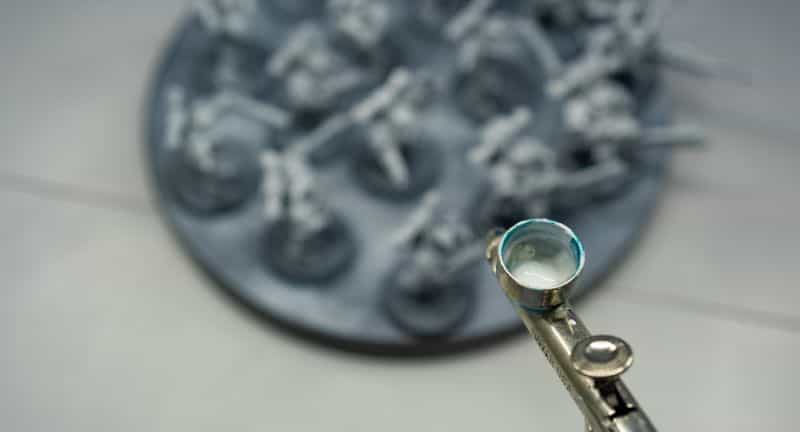
Working indoors with water based paints or solvent paints will be a challenge without good airflow. Even with a window open, you will need to push that contaminated overspray air outside.
Of course, if you don’t have a window to ventilate air from your airbrushing area, there are a few things you can do to further reduce your risk for breathing in sprayed paint (more about this below).
Is Acrylic Model Paint Toxic?
I’ve written about the toxicity of hobby acrylic paint in another article. When it comes to airbrushing, however, there isn’t much safety data available. If you have no ventilation to airbrush inside, then you may be wondering if it is still safe. A little paint isn’t bad for you, right? Well, let’s take a closer look.
Acrylic hobby paint with the non-toxic label are safe when you use them as they are intended–using a paint brush with the occasional splash or spill on your skin or maybe even a some brush-licking.
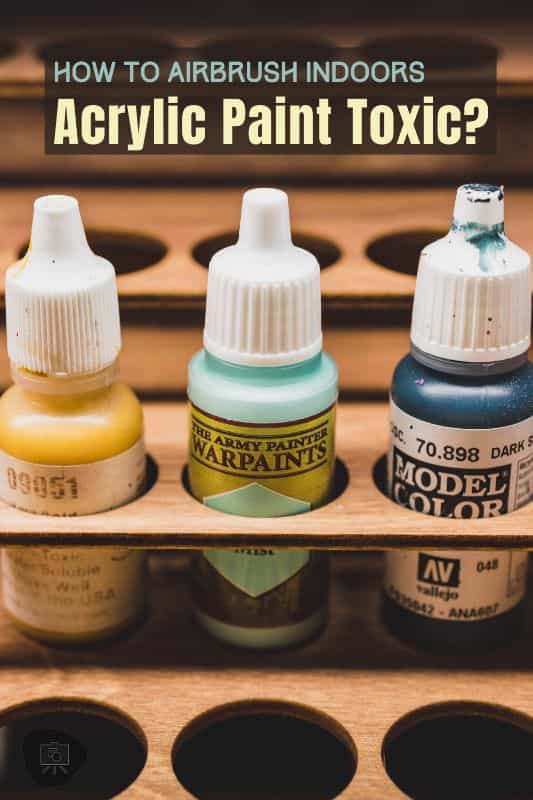
However, whether airbrushing acrylic paint indoors is safe or not is not a question that can be answered. All we know is that breathing anything into your lungs, except clean, fresh air, is probably bad for you. Water based paints are certainly better than using solvents that produce a harmful overspray, and require a proper vent system. For more details about non-toxic, airbrush-ready paints, check out this article.
Those paint particles can irritate the sensitive mucus linings of your bronchial tubes, exacerbate respiratory issues, e.g., asthma, and may lead to some serious discomfort. I’ll admit here that I don’t think you’ll die from breathing in acrylic paint spray from airbrushing.
What About the Safety of Aerosol Spraying Indoors?
I would not spray aerosol indoors unless you have really good ventilation. Aerosol primers and paints (those that come in rattle spray cans) contain volatile chemical compounds that are very hazardous to breath.
The following harmful compounds may be found in aerosol spray paints.
- Toluene
- Xylene
- Acetone
- Methanol (wood alcohol)
- Ethylbenzene
- Propylene glycol mono butyl ether
- Liquefied petroleum gas
- Magnesium silicate
A “volatile chemical” is a molecule with high vapor pressure, which means it has a tendency to easily become a gas. The most common chemicals in spray can include toluene, xylene, and acetone. Some of these chemicals are highly flammable, while others may be carcinogenic (or cancer causing) (source).
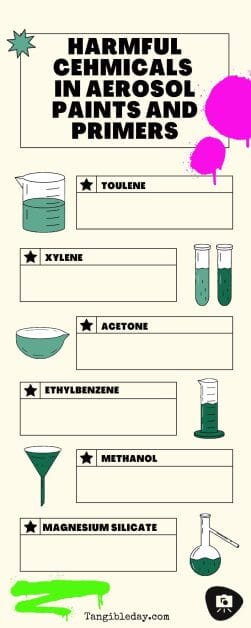
The U.S. Environmental Protection Agency (EPA) warns about the risks of spraying aerosols indoors: When these aerosol products are used indoors, harmful levels of volatile organic compounds (VOCs) can quickly build up in the air. People can be exposed to VOCs by breathing them in, getting them on their skin, or eating or drinking them.
Chronic (long-term) exposure may cause cancer or harm a person’s liver, kidneys and central nervous system. Short-term exposure to high levels of VOCs can cause headaches, dizziness, nausea and irritation of the eyes, nose and throat.
Aerosol spraying versus airbrushing
In contrast to airbrushing acrylic paints, where you can control the amount of air that comes out of your airbrush, aerosol paint spray cans emit a larger, uncontrollable volume of gas when your trigger the nozzle. This means that if you are not in an area with proper ventilation, you can quickly become exposed to dangerous levels of hazardous chemicals, like VOCs. Using an airbrush produces less overspray and doesn’t create the harmful fumes of aerosols.
That being said, this is the reason I don’t think aerosol paints are the best sort of tool for most kind of hobby modeling applications–this includes painting miniatures, wargaming models, etc., where aerosol paints will help you paint faster, but may obscure fine details or limit you to a baseline tabletop standard paint job.
RELATED: SPRAY PRIMER VERSUS BRUSH-ON PRIMER (PROS AND CONS)
For painting Warhammer 40k, Age of Sigmar, or other tabletop games, aerosol spray paints and primers are brute force tools. You can certainly make a mess with them.
Bottomline: Try to avoid spraying aerosol paints and primers indoors
How to Airbrush Safely Indoors
There are a five ways you can airbrush indoors without using windows for ventilation:
1. Use a Spray Booth
If you have the space, a spray booth is the best way to go. A tabletop spray booth will help contain the fumes and keep them from dispersing throughout your hobby room. Spray booths are especially good if you’re concerned about the paint mist settling on your furniture or flooring. Consider that using a spray booth may reduce health issues, and in the long run is a lot cheaper than a medical bill.

The setup of a good spray booth doesn’t require a lot of room. You can setup an airbrush spray booth in a garage, basement, or a separate room. The vent and filter in a spray booth will contain and trap paint overspray and are best used with acrylics, which don’t pose much of a hazard as VOC containing paints and primers, e.g., aerosol spray cans.
2. Wear a Respirator Mask
If you don’t have a spray booth, using a respirator mask is your next best bet. A respirator face mask will help protect you from the fumes and keep them out of your lungs. Be sure to get a good seal around your face so that no fumes can escape. Clean up with a spray booth is also easier as the filter traps the paint particles.
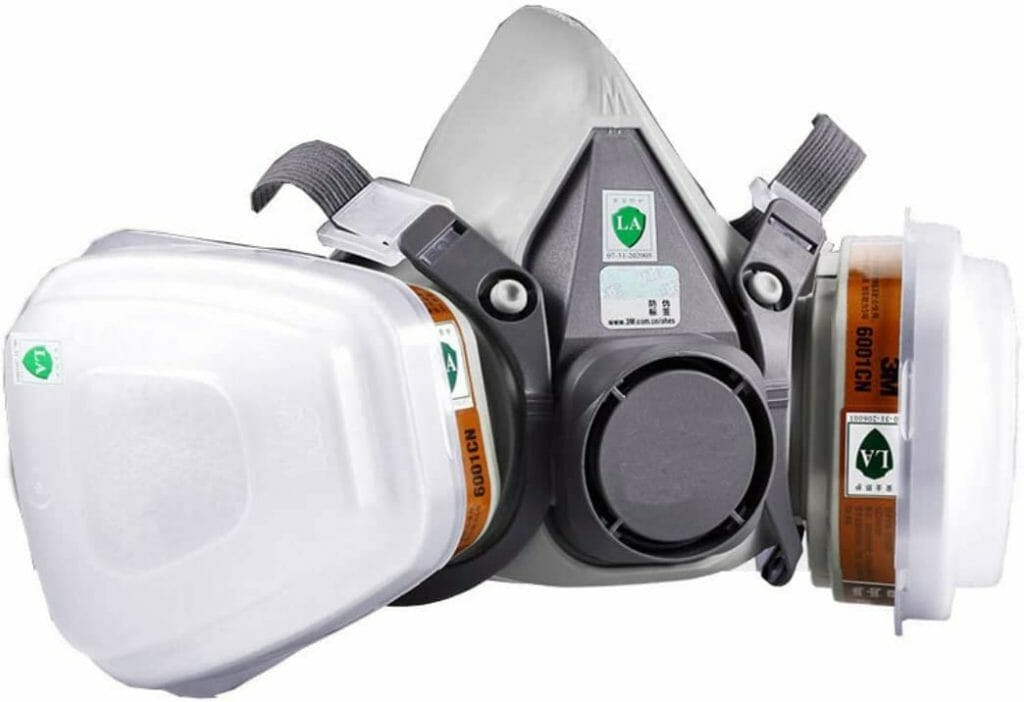
For those using oil based paints, I would not recommend using a simple dust mask. You’ll want to wear a breathing mask with an activated carbon filter that absorbs volatile solvent compounds, such as toluene and xylene. Only a couple of face mask models use these kinds of filters, so make sure you get the right one. They are pretty affordable, easy to wear, and useful for all sorts of other household tasks.
3. Use a Fan
If you don’t have a spray booth or respirator mask, using a fan can help move the fumes away from you and your work space. Position the fan so that it’s blowing the fumes away from you and your work space. This is not as ideal as a spray booth or respirator mask, but it’s better than not using anything at all!
A simple bathroom fan with a hose attached to it that runs from your spraying area to the floor or into another room will keep the dust and fumes away from your lungs.
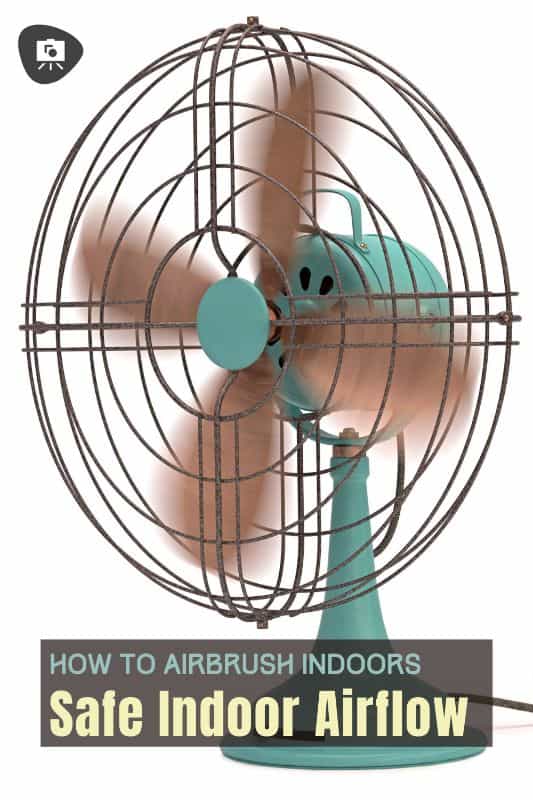
Of course, the atomized spray will float in the air nearby. So, it is best if you can use the fan to blow the overspray into another room, into a cardboard box, or ideally onto or straight-through some kind of filter. This latter idea functions almost like a spray booth, except it’s janky and won’t always capture those sprayed pigments.
4. Setup a Workshop Air Purifier
If you are really concerned about the paint contaminated air from your airbrushing, you can purchase a workshop air purifier. These plug into an electrical outlet and help clean the air in your space, removing many of the atomized paint particles and other dust chemicals from the air.
Workshop purifiers can be expensive, however, depending on how powerful and effective they are for your particular space. Make sure your system is rated for the size of the room you plan to work in.
5. Airbrush a Water-Based Acrylic Paints
Airbrushing water based paint should not expel any harmful gases or VOCs. The only concern you would have is the paint particles that you’ve sprayed through the airbrush. Acrylics atomize and dissipate quickly through a room, falling slowly onto nearby surfaces.
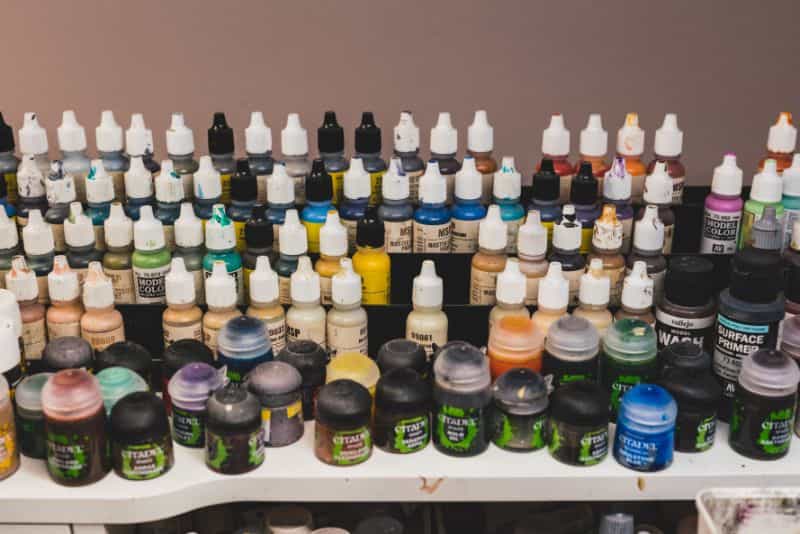
In your house, garage or other room you work in, acrylics don’t pose much of a hazard as long as you don’t inhale it in any significant quantity. There are airbrush-ready paints you can buy to paint models, and are non-toxic for this use.
In general, acrylics are water-soluble, which makes spraying them fantastic for painting model kits and miniatures. Simply thin acrylics with a bit of water for your airbrush or spray gun and paint away.

If you are thinning your hobby paints for an airbrush, make sure you dilute your paint in water, rather than a chemical solvent, e.g., ammonia, flow-aid. I think you’d rather spray mists of water than clouds of ammonia, e.g., windex, or rubbing alcohol. The latter two solvents are really, really bad to breath into your lungs.
Other sites may suggest using window cleaner for diluting hobby paint, but this isn’t recommended. Window cleaner solutions are made for dissolving grease and oils, not acrylic paint. Although there are several good points of discussion about paint thinning and airbrushing, the consensus is that if your paint is water-based (most hobby paints are), then try thinning with water first (source).
Frequently Asked Questions (FAQ)
What are the risks associated with improper ventilation?
It is possible that paint particles can be accidentally inhaled, irritate your respiratory system, and lead to tissue damage. Any foreign material, including paints, can be disruptive to your ability to breath, especially if you’re exposed for prolonged periods. As an example of how seriously I take using aerosols in my hobby work, I will often spray paint with aerosols in the garage with the door open. This lets me stay sheltered if it is rainy or too warm out in the sun, while keeping the airflow fresh.
Can I use spray paint instead of an airbrush?
Spray paint is not the same as an airbrush and should not be used as a substitute. Airbrushes produce much finer particles than spray cans, for example. Airbrush paint and thinned acrylic model paints will aerosolize with a significantly less dense output than aerosol spray paint. This allows you to operate an airbrush at really low air pressure (<30 PSI) and still have great atomization for painting small models and miniatures.
Can you use an airbrush without ventilation?
If you are using an airbrush with water-based paints, then you may in fact have no need for proper ventilation. As mentioned above, water-based acrylic paints are generally safe but can lead to respiratory trouble if inhaled. Of course, the risks to you are related to how frequent you airbrush, how much volume of paint is sprayed (related to your PSI air pressure), and other factors.
Note that if you are using an airbrush with volatile solvent-based paints, then it is advised to use a spray booth, respirator mask, or fan to help move the fumes away from you. See above. Failing to do so could result in you inhaling harmful chemicals and particles.
Do I need a spray booth for airbrushing?
Here are 7 reasons you may want a spray booth for airbrushing your miniatures and models.
A spray booth has several benefits for airbrushing. If you are indoors, the fan in the spray booth pulls paint particles in the air away from you to keep them from concentrating in your immediate work space. When you are finished painting, the fan continues to clear away most of the paint particles floating around your painting area.
Popular Spray Booth Models for Airbrushing Miniatures
| Image | Model | Features |
|---|---|---|
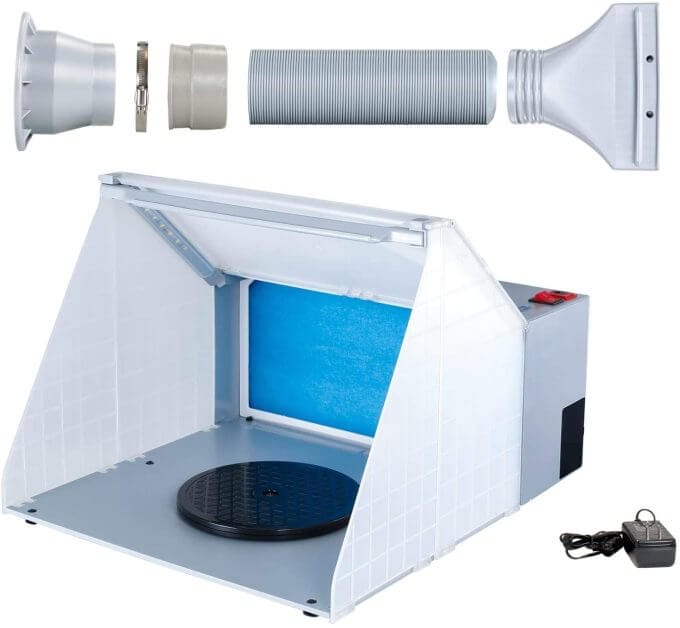 |
Master Airbrush Lighted Portable Hobby Spray Booth | The best value spray booth for airbrushing miniatures. Simple, compact, with built-in LED lighting. |
 |
VIVOHOME Portable Paint Spray Booth Kit LED Lights | Similar to the Master Airbrush Spray Booth. This is a portable spray booth with LED lights, and an efficient air extraction system. |
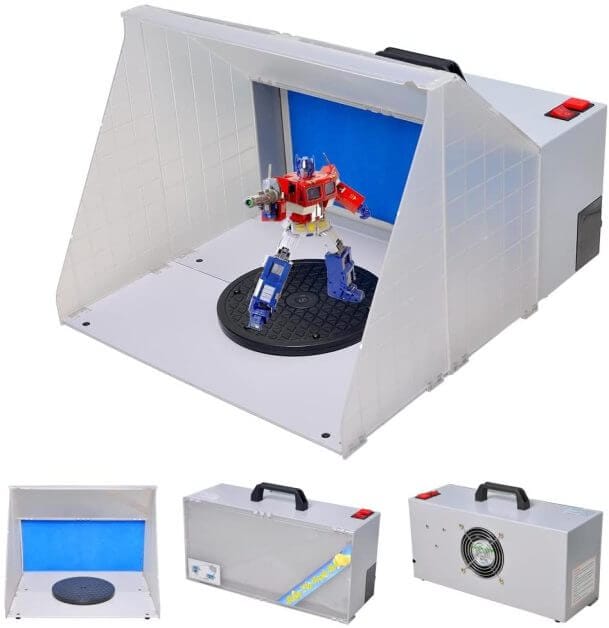 |
WeChef Portable Airbrush Craft Spray Booth Kit | The hobbyist’s spray booth that has everything you need to get started airbrushing. Compact and functional. |
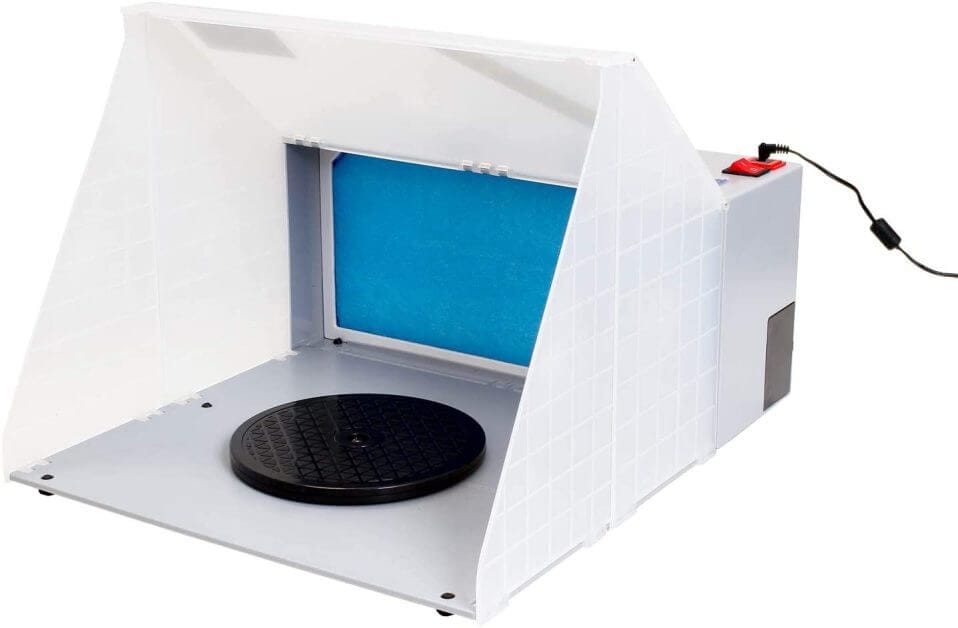 |
Master Airbrush Portable Hobby Airbrush Spray Booth | This is the spray booth for those who want simplicity in a portable spray booth. Compact, easy-to-store, and works great. |
 |
Paasche HSSB-16-13 Hobby Spray Booth | Great airflow extraction will contain most airbrush overspray in this portable spray booth. This is made by a Paasche, a well-respected airbrush company. |
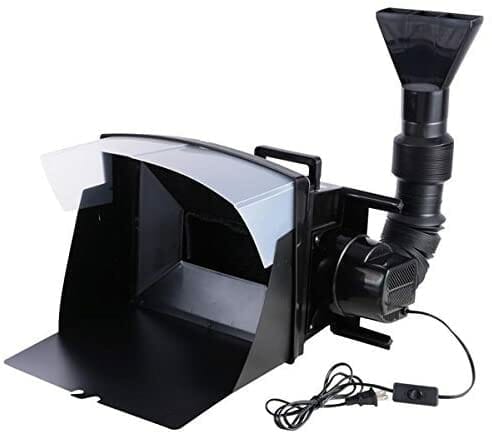 |
Portable Airbrush Spray Booth Kit Odor Eliminator | Inexpensive. This compact spray booth competes well with DIY versions with similar components. |
 |
OPHIR Portable Airbrush Lighted Hobby Spray Booth | This is a hobby spray booth has built-in lighting and other useful features. Folds down into a suitcase for travel or storage |
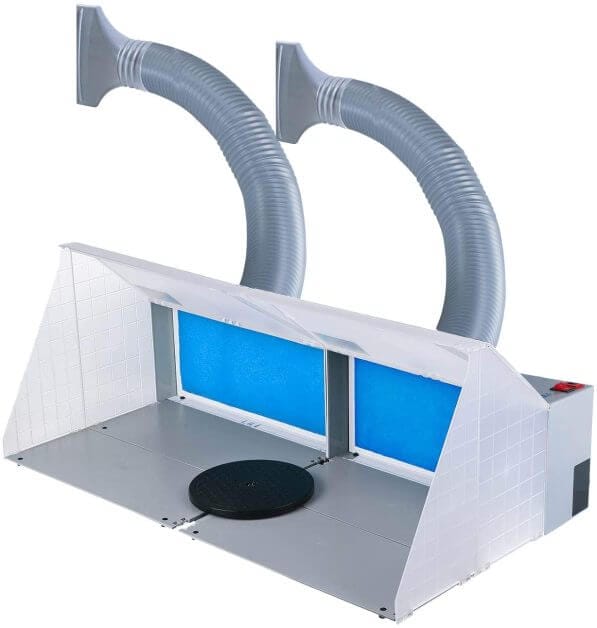 |
Master Airbrush Dual Units Portable Hobby Craft Spray Booth | The dual spray booth setup is portable, folding into two suitcases. Each module has an independent fan system. Combine the units for extended spraying workspace. |
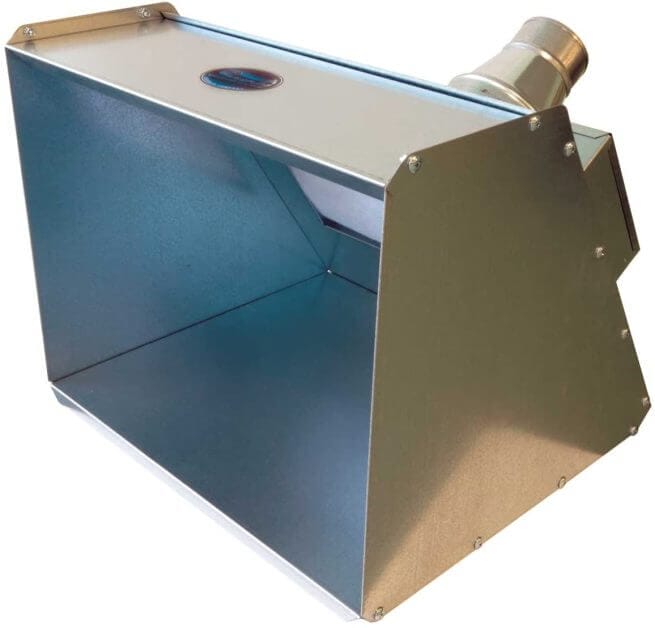 |
Paasche HSSB-22-16 Hobby Spray Booth | This is an all-metal constructed spray booth designed for dedicated, professional airbrushing and other spray application. A powerful and quiet fan draws up to 8 cubic meters/min of air for efficient spray containment. |
 |
HomeRight C900146 Air Flow Spray Shelter | This is a flexible pop-up fabric shell that will passively or actively contain overspray (if you add the optional fan and filter). You can place the large spray shelter on a tabletop or on the ground. Useful indoors or outdoors. |
Final Word
Airbrushing can be a great way to speed up the painting process, but it’s important to take the necessary precautions to avoid any health risks.
While water-based acrylic paints are generally safe to use, they can lead to respiratory trouble if inhaled. Volatile solvent-based paints, on the other hand, can be very hazardous and should always be used in a spray booth or with the proper safety equipment. Taking precautions when airbrushing indoors will ensure that you’re not putting your health at risk.
The tips above should give you a better idea of how to work safely while airbrushing indoors.
I hope this article was helpful! For more information, check out other articles linked in the page above, and feel free to leave me a comment below!



Tangible Day on YouTube (Miniatures and More!)


Pingback: How do I remove createx paint? – AnswerParadise.net